
Offshore Electrical Engineering e-bog
591,74 DKK
(ekskl. moms 473,39 DKK)
Offshore Electrical Engineering is written based on the author's 20 years electrical engineering experience of electrical North Sea oil endeavor. The book has 14 chapters and five important appendices. The book starts with designing for electrical power offshore application, especially with aspects that are different from land based structures, such as space and weight limitations, safety haz...
E-bog
591,74 DKK
Forlag
Butterworth-Heinemann
Udgivet
22 oktober 2013
Længde
306 sider
Genrer
Engineering: general
Sprog
English
Format
pdf
Beskyttelse
LCP
ISBN
9781483163260
Offshore Electrical Engineering is written based on the author's 20 years electrical engineering experience of electrical North Sea oil endeavor. The book has 14 chapters and five important appendices. The book starts with designing for electrical power offshore application, especially with aspects that are different from land based structures, such as space and weight limitations, safety hazards at sea, and corrosive marine environment. The criteria for selecting prime movers and generators, for example, gas turbines and reciprocating engines, depending on the type of applications, are examined. The machinery drives are then discussed whereby the different offshore electric motor ratings are considered. As in any electrical system, the use of ergonomically designed controls is important. Distribution switchgear, transformers, and cables are described. The book also explains the environmental considerations, power system disturbances, and protection. In an offshore structure, lighting requirements and subsea power supplies, diving life support system, and equipment protection are emphasized. A reliability analysis is also included to ensure continuance of service from the equipment. A general checklist to be used when preparing commissioning workscopes is included, and due to space and weight limitations on offshore installation, the rationale of maintenance and logistics options are explained. The appendices can be used as guides to descriptions offshore installations, typical commissioning test sheets, computerized calculations program, and a comparison of world hazardous area equipment. The text is a suitable reading for offshore personnel, oil-rig administrators, and for readers from all walks of life interested in some technical aspects of offshore structures.
 Dansk
Dansk

